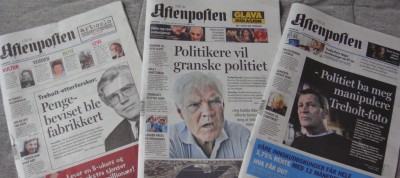Further revelations have been published in the last few days regarding the near 30-year-old Cold War spying case of Arne Treholt, as the deadline for making official comments to the Criminal Cases Review Commission passed.

Treholt was originally sentenced to 20 years in prison for spying for the Soviet Union and Iraq in 1985. The potential reopening of the case hinges on whether evidence that Treholt had a suitcase full of money in his home was tampered with or not. The defense claims that photographs taken of the suitcase before his arrest and the search did not have a piece of tape on it, while tape was present in pictures afterwards, suggesting that evidence had been falsified.
British, Swedish and Danish reports
A report by British firm LGC Forensics, commissioned by Treholt himself, gave “strong support” for the defense team’s argument that there were no pieces of tape on the case when Treholt was photographed just before his arrest. Two other reports, by the Swedish National Laboratory of Forensic Science (SKL) and the Danish police force, concluded that the tape may not have been seen because the case was held the “wrong way,” although this conclusion was not as certain as the firm statement given by LGC Forensics.
LGC Forensics was also brought in to evaluate the reports by SKL and the Danish police under an agreement between Treholt’s lawyers and the commission. Their senior researcher, Clive Richard Burchett, poured scorn on the work produced by the Swedes and Danes. He suggested, amongst other things, that neither had done the necessary photogrammetric or morphological testing required to reach conclusions on the issue, and had not given detail about their methods, meaning that the results could not be checked.
Another British report, also commissioned by Treholt and undertaken by the Berkeley Security Bureau Forensic (BSB), was last week sent to the commission. They also claim that there is “no doubt” that Treholt was holding the case the “right way.” BSB are known for doing similar work for British public prosecution authorities.
Judgment pages altered
Writer Arild Rønsen, who has supported Treholt’s attempts to clear his name since his arrest in 1984, also published new allegations this week that parts of page 66 of the original judgment, which contains information regarding some of the most important evidence in the case, had its contents altered. He claims that he has examined three different versions of the page – one from 1985, another released in 1991 and a final page photographed by newspaper VG in 2005. There are differences between the writing on the 1985 and 1991 documents in particular. Photocopying experts have reportedly confirmed that it is impossible that the discrepancies between the two versions can be this large through photocopying issues alone.
Rønsen told Norwegian Broadcasting (NRK) that “the margins are different and written marking has been done by different writing equipment than has been claimed by the police.” The writer has asked the police if he can see the originals, but this has been refused and the police will not comment further on the issue. Rønsen believes that the police falsified the documents because they lacked sufficient evidence and needed the money evidence in particular to stick.
In response, government lawyer Stein Vale stressed to NRK that “in 2007, Swedish experts evaluated the original version and three copies from page 66” and concluded that the copies did indeed come from the original, adding that “I do not believe that there is anything new in Rønsen’s examination.”
Commission to consider submissions
The commission considering Treholt’s application to reopen his case is entering its final phase. The infamous case received huge attention in the Norwegian press at the end of last year after a book, called The Forgery, put forward claims that the police tampered with the money evidence, and in particular that pictures of notes found in Treholt’s suitcase were taken after it was supposedly searched on August 22 1983. Like Treholt himself, the study claims that this search never actually took place, meaning that no money was ever found at his home.
On Thursday 14 April, Treholt’s defense team, led by Harald Staball, gave its submission to the report. They repeated their demands for an open hearing of all experts involved in examinations of the suitcase. They maintain that the evidence was fabricated. Speaking to newspaper Aftenposten, the commission leader, Helen Sæter, confirmed that they would meet after Easter to debate what they had received, meaning “it is too early to say anything on both the expert hearing or when the commission can give its final answer on reopening the case.”
Treholt, a former Labour Party politician, was controversially pardoned for health reasons by a Labour government in 1992. He then moved to Russia before ending up in Cyprus, where he has become a successful businessman. In 2008, the Criminal Cases Review Commission considered and rejected reopening the case.
Views and News from Norway/Aled-Dilwyn Fisher
Join our Reader Response if you’d like to comment on this story.

